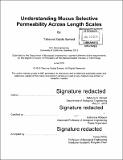| dc.contributor.advisor | Katharina Ribbeck. | en_US |
| dc.contributor.author | Samad, Tahoura Sajida. | en_US |
| dc.contributor.other | Massachusetts Institute of Technology. Department of Biological Engineering. | en_US |
| dc.date.accessioned | 2020-11-23T17:41:04Z | |
| dc.date.available | 2020-11-23T17:41:04Z | |
| dc.date.copyright | 2019 | en_US |
| dc.date.issued | 2019 | en_US |
| dc.identifier.uri | https://hdl.handle.net/1721.1/128603 | |
| dc.description | Thesis: Ph. D., Massachusetts Institute of Technology, Department of Biological Engineering, June, 2019 | en_US |
| dc.description | Cataloged from PDF version of thesis. "Thesis submitted without pagination"--Disclaimer page. | en_US |
| dc.description | Includes bibliographical references (pages [97]-[109]). | en_US |
| dc.description.abstract | Mucus is a hydrogel that covers all wet epithelia in the human body including the eyes, respiratory, gastrointestinal and female reproductive systems. While mucus is sometimes characterized as a waste product, it actually has essential roles in the human body and complex impacts on health. Mucus is the habitat for many of the trillions of microbes in the human body, and has been shown to impact the physiology and virulence of its microbial residents. Mucus is also a selectively permeable barrier, which protects the underlying epithelium by binding and restricting the passage of harmful particles, while simultaneously permitting the passage of essential particles like nutrients and oxygen. Unfortunately, this protective ability can also limit the effective delivery of therapeutics, which are prevented from reaching their intended targets or inactivated. Despite the widespread impacts on human health outlined above, there exist many gaps in our understanding of mucus permeability. | en_US |
| dc.description.abstract | In this thesis, I first considered the impact of mucus selectivity, examining the effect of mucus selective permeability on the efficacy of antibiotics used to treat bacterial pathogen Pseudomonas aeruginosa, which forms serious infections within mucus. We found that mucus reduced the efficacy of multiple classes of antibiotics, due in some cases to mucus-antibiotic binding. This result motivated further studies to understand the detailed molecular properties that distinguish particles that bind and are rejected by mucus barrier from those that permeate, as this knowledge will enable us to predict which therapeutics may be impacted by mucus, and rationally design therapeutics that are effective in mucus. I investigated this question first at the length scale of peptides and found that spatial arrangement of charge and hydrophobicity can be used to tune the accumulation and penetration of a peptides within a mucus layer, creating a continuum of transport behaviors. | en_US |
| dc.description.abstract | I then built on this understanding to ask a similar question for nanoparticles, examining the transport of libraries of surface-modified phage through mucus. Finally, I considered how passively diffusing particles that can be found within mucus, like nonmotile mucosal bacteria S. aureus, may harness the active motility of bacteria in the same community as a strategy to transport long distances. | en_US |
| dc.description.statementofresponsibility | by Tahoura Sajida Samad. | en_US |
| dc.format.extent | 109 unnumbered pages | en_US |
| dc.language.iso | eng | en_US |
| dc.publisher | Massachusetts Institute of Technology | en_US |
| dc.rights | MIT theses may be protected by copyright. Please reuse MIT thesis content according to the MIT Libraries Permissions Policy, which is available through the URL provided. | en_US |
| dc.rights.uri | http://dspace.mit.edu/handle/1721.1/7582 | en_US |
| dc.subject | Biological Engineering. | en_US |
| dc.title | Understanding mucus selective permeability across length scales | en_US |
| dc.type | Thesis | en_US |
| dc.description.degree | Ph. D. | en_US |
| dc.contributor.department | Massachusetts Institute of Technology. Department of Biological Engineering | en_US |
| dc.identifier.oclc | 1221003917 | en_US |
| dc.description.collection | Ph.D. Massachusetts Institute of Technology, Department of Biological Engineering | en_US |
| dspace.imported | 2020-11-23T17:41:03Z | en_US |
| mit.thesis.degree | Doctoral | en_US |
| mit.thesis.department | BioEng | en_US |
